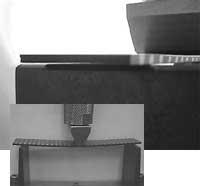Influence of anisotropy on bending tests
In order to investigate the influence of anisotropy, Faustino Mujika studies the behavior of composites in a project supported by the Provincial Council of Gipuzkoa. At the University School of Industrial Technical Engineering in San Sebastian interesting results have been obtained on the cutting module.
Anisotropic materials are materials that modify their properties depending on the direction. The composite materials hardened by long fibre are anisotropic, since in the direction of the fibers (0º) appear the highest mechanical properties and the lowest properties in the direction perpendicular to the fibers (90º). In intermediate orientations, mechanical properties are variable from angle. To measure the basic cutting properties of materials, Faustino has performed bending tests with samples with oriented fibers.
A simple method was used to perform bending tests, consisting of placing the composite sample on two supports and then applying a central force. To calculate the maximum force, the cutting strength of the composite is first studied. That is, different forces are applied in the samples until they find the minimum force that produces the break. The force applied to bending tests has been equal to or less than a third.
Bending and twisting

When the sample is placed on two supports, when applying force the phenomenon of bending occurs, that is, the sample takes the form of U. It should be noted, however, that in addition to bending occurs the phenomenon of torsion. Being the rectangular sample, one edge of the side stands and the other on the same side supports all the strength. On the other side the same phenomenon occurs, but on the opposite end. Thus, the sample rises on the two diagonal ends and only poses on the other two (see figure).
Cutting module
The mechanical behaviour of composites is defined by 9 elastic constants. Simplifying calculations only takes into account four: EL, ET, <unk> LT and GLT or cutting module.
EL, ET and <unk> LT measurement procedures are set, but the problem is to calculate the value of the cutting module. Although there are different measurement methods, the results vary greatly depending on the method. In addition, all of these methods include non-simple testing procedures.
The elastic properties of the material depend on the direction of the fibers and the four elastic constants mentioned above. The tests consist of measuring the applied force and the displacement of the application point, and subsequently, knowing the values of the other three constants, releasing GLT from the theoretical equation.
Faustino has performed 50 tests under different conditions using fiber samples of 15º, 30º, 45º, 60º and 75º, obtaining the same results for the cutting module. In addition, the sample survey in direction 75º should be theoretically 0, and has experimentally obtained the same result. The classical theory of composite beams does not take into account the influence of torsion, but according to the work carried out the importance of torsion has been observed.
The cutting module was obtained from complicated essays and simple interpretations, now obtained from the realization of a simple essay and a new deeper theoretical interpretation.
Project title:Analysis of cutting properties in single-direction fiber composite materials by bending tests. Objective:Measurement of rigidity and resistance to cutting of composite materials. Director: Faustino Mujika Garitano. Team:Materials + technologies directed by Iñaki Mondragon. Department: Chemical Engineering and Mechanical Engineering. Faculty:University School of Industrial Technical Engineering. Funding Diputación Foral de Gipuzkoa. |





